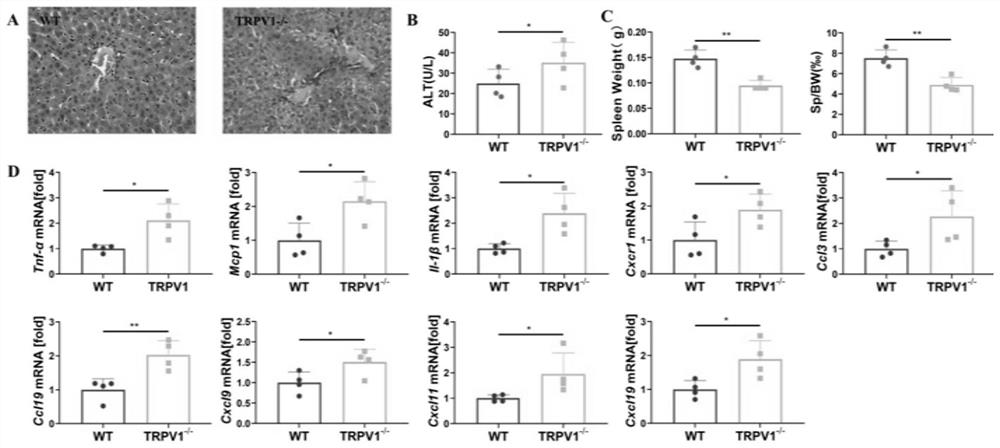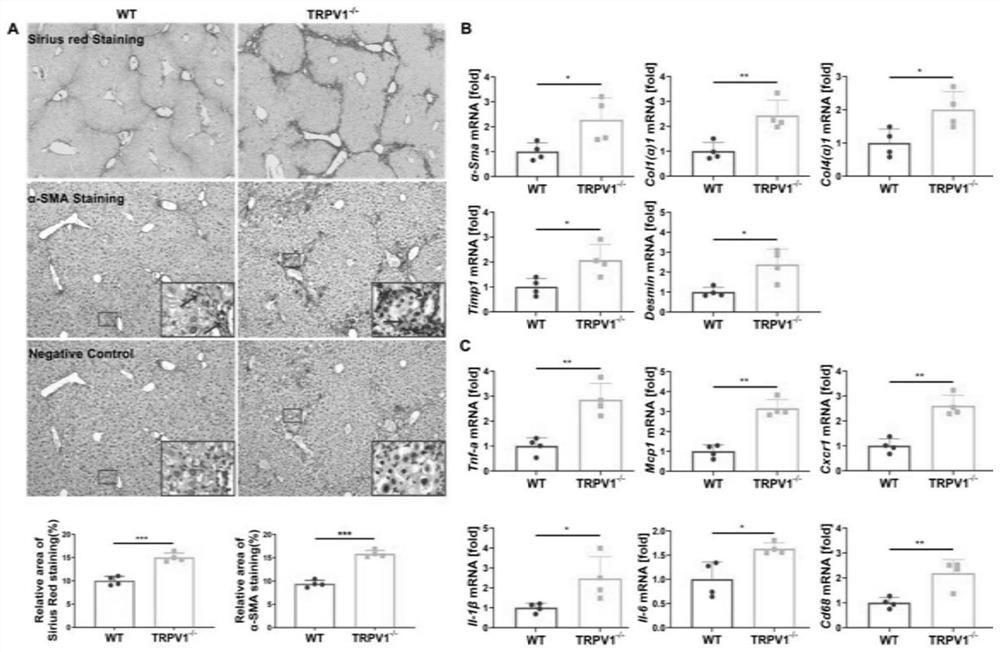Application of TRPV1 in screening or preparing medicine for preventing, relieving and/or treating liver diseases
A technology for liver diseases and drugs, applied in the field of gene function and application, can solve the problems that have not yet been seen in relevant research reports.
- Summary
- Abstract
- Description
- Claims
- Application Information
AI Technical Summary
Problems solved by technology
Method used
Image
Examples
Embodiment 1
[0093] Example 1. TRPV1 knockout aggravates acute liver injury
[0094] (1) Experimental process
[0095] Construct the acute liver injury model of TRPV1 knockout mice: 4 8-week-old male C57 / BL wild-type mice served as WT group (control group), 4 same-week-old male TRPV1 - / - Mice as TRPV1 - / - group (TRPV1 knockout group).
[0096] The mice in the two groups were intraperitoneally injected with lipopolysaccharide LPS (10 mg / kg mouse body weight), and sacrificed 18 hours later. The body weight and spleen weight of the mice were weighed, and the spleen-to-body ratio was calculated. Serum and liver were collected for relevant tests: mouse liver function test and expression of inflammatory factors.
[0097] (2) Experimental results
[0098] The result is as figure 2 As shown, compared with WT group, TRPV1 - / - The spleen weight of mice in the group was significantly reduced, and the ratio of spleen to body was significantly reduced ( figure 2 C), the serum liver function (...
Embodiment 2
[0100] Example 2, TRPV1 knockout aggravates liver fibrosis
[0101] (1) Experimental process
[0102] Construction of TRPV1 knockout mouse model of liver fibrosis: 4 8-week-old male C57 / BL mice as WT group, 4 same-week-old male TRPV1 - / - Mice as TRPV1 - / - Group. intraperitoneal injection of CCl 4 (10%CCl 4 , 0.04ml / only), 3 times a week for 6 consecutive weeks. 72 hours after the last injection, the animals were sacrificed, and the liver and serum were collected for related testing: pathological testing of Sirius red staining and expression of α-SMA; PCR testing of expression of inflammatory factors and fibrosis indicators.
[0103] (2) Experimental results
[0104] The result is as image 3 As shown, Sirius red staining showed that the fibrous septa in the liver tissue of mice in the WT group were narrow and arranged loosely and discontinuously, while TRPV1 - / - In the group, hyperplastic collagen fibers separated the liver lobules to form thicker intervals, and the st...
Embodiment 3
[0106] Example 3, TRPV1 overexpression relieves liver fibrosis
[0107] (1) Experimental process
[0108] To construct a mouse liver fibrosis model with TRPV1 overexpression: 12 8-week-old male C57 / BL mice were randomly divided into control group (LV-Con) and overexpression group (LV-SMA-TRPV1). 6 only. Two groups of mice were injected with 10% CCl 4 Olive oil, 0.04ml / mouse, 3 times a week, for 6 consecutive weeks; mice were injected with CCl 4 Two weeks after modeling, mice in the LV-SMA-TRPV1 group were injected with TRPV1 lentivirus (LV-SMA-TRPV1) through the tail vein; mice in the LV-Con group were injected with the same volume and amount of control virus (LV-Con). Last injection of CCl 4 The olive oil was sacrificed 72 hours later, and relevant tests were carried out: detection of mouse liver function and pathological changes; immunohistochemical detection of α-SMA expression; PCR detection of expression of fibrosis indicators and inflammatory factors.
[0109] (2) E...
PUM
 Login to View More
Login to View More Abstract
Description
Claims
Application Information
 Login to View More
Login to View More - Generate Ideas
- Intellectual Property
- Life Sciences
- Materials
- Tech Scout
- Unparalleled Data Quality
- Higher Quality Content
- 60% Fewer Hallucinations
Browse by: Latest US Patents, China's latest patents, Technical Efficacy Thesaurus, Application Domain, Technology Topic, Popular Technical Reports.
© 2025 PatSnap. All rights reserved.Legal|Privacy policy|Modern Slavery Act Transparency Statement|Sitemap|About US| Contact US: help@patsnap.com



